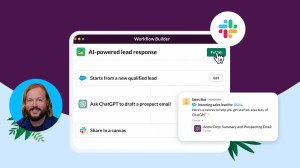Since its public rollout in 2014, Slack has steadily evolved from the acronym it’s named for (searchable log of all conversation and knowledge) — to a productivity platform that has fundamentally shifted how work gets done.
Earlier this month, the company released a next-generation platform that makes it easier to automate and integrate everything with Slack — no matter a person’s level of technical experience or coding proficiency. From creating no-code workflows and custom integrations to embedding generative AI, with the new platform, using the data in Slack is now simpler, more automated, and more intelligent.
Slack’s SVP of Product and Platform, Steve Wood, has a history building low-code platforms like these both within Salesforce and as a startup founder. As he explains it, putting automation and generative AI directly into customers’s hands is the next big step forward in Slack’s journey to transform not just the way people work, but how machines and people interact in the future.
Here, Wood shares a behind-the-scenes look of the new Slack platform, insights on how Slack GPT will supercharge automation, and what his team will be looking out for as the tech continues to evolve.
Q: How would you explain the newly-released Slack platform and what makes it so unique and malleable?
The Slack platform has always been about engagement: how do we engage every user, regardless of their technical expertise, to be able to automate their work in Slack?
The new version of our platform that became generally available to developers last month offers a modular architecture grounded in ‘building blocks’ like functions, triggers, and workflows that are remixable, reusable, and hook into everything flowing in and out of Slack. For example, developers can build bespoke solutions to integrate with the Salesforce platform, enabling users to collaborate more effectively and automate workflows across sales, service, marketing, and commerce, directly in the flow of work.
With the new platform and the launch of Slack GPT, developers can also code workflows that embed AI actions with simple prompts at each step, making it easy for anyone to deploy AI-powered automation. That capability will be released this summer via Slack’s no-code automation tool, Workflow Builder.
All of this empowers people – whether they’re developers or not – to make whatever they do at work easier and more efficient.
All of this empowers people – whether they’re developers or not – to make whatever they do at work easier and more efficient.
Q: What is it about low-code automation that makes this all possible for builders and end users?
When new technologies come out, the developers and experts are the first to use it. Low code brings more and more people into the tools – whether through apps or AI – so everybody can benefit.
We want the Slack platform to be super easy to discover and use, and then, if you’re feeling brave, you can join the low-code revolution. You can remix and reuse building blocks to form your workflows, add your own changes, and publish your improvements to it. You can supercharge everything you do through customization in Slack.
Q: How does that change or evolve with generative AI?
I truly believe that data paired with AI and automation will transform the way we work.
When they made a conversational interface for ChatGPT, it was like, ‘Wow, now everybody can interact with this advanced AI in new ways,’ and you saw an explosion of use, which we’re also seeing with Slack. Slack becomes a conversational interface that helps customers work smarter, learn faster, and communicate better.
Low code has simplified automation into building blocks that are reusable by both humans and machines. Pair that with generative AI on your trusted company data stored in Slack and Salesforce, and we have the potential to completely reshape how we interact with technology. We may look back five years from now and go, ‘Remember when we used to work with computers like that, typing stuff into fields manually? That was kind of crazy.’ It reminds me of when the iPhone was first released – everyone knew it was a big deal, but only years later was the full potential realized.
Q: How would you explain the recent Slack GPT news?
For one, Slack GPT brings generative AI natively into the user experience of Slack to do things like summarize conversations and huddles, or edit a message.
Here’s why that’s so powerful: Somebody once joked with me that being away from Slack for a few weeks is like going on vacation and looking at your credit card statement when you return. You might have this overwhelming feeling and think ‘Oh wow, I’ve got a lot to catch up on.’ With Slack GPT, you can summarize all of the messages that came in while you were gone to get you up to speed quicker.
With native AI delivered right into Slack’s user interface, it will all be possible with just a click.
Q: What else will we see as part of Slack GPT?
With the Einstein GPT app for Slack, Slack will be the conversational interface to Customer 360, soon bringing Einstein GPT-powered insights from real-time customer data to life in Slack and enriching every team’s understanding of their customers.
And the part I’m most excited about, is that Slack GPT also allows you to integrate and automate your LLM of choice, whether that’s a partner-built app like OpenAI’s ChatGPT, Anthropic’s Claude, or a custom integration. You’ll also be able to instantly bring generative AI into your automated processes. For example, you could build an AI-powered workflow so that when a new lead comes in from Sales Cloud, ChatGPT could use CRM data to draft a personalized prospecting email for you, put it in a document, and share it in a channel. Now, you have a huge head start to follow up on the lead.
When you think about all of these innovations within Salesforce, with the combination of Einstein GPT, Data Cloud, Customer 360 and now Slack GPT, you have an incredible nexus of forces coming together to supercharge Slack and Salesforce. It creates incredible opportunities for customers to transform the way they work.
When you think about all of these innovations within Salesforce, with the combination of Einstein GPT, Data Cloud, Customer 360 and now Slack GPT, you have an incredible nexus of forces coming together to supercharge Slack and Salesforce.
Q: AI gets better and smarter over time. Will your team look at how people are using Slack GPT for AI-powered automation and optimizing what it can do as well?
What we’re most excited to see is what people do with Slack GPT when it’s out in the wild. Seeing how people actually use new technologies, versus what we developers think of how people will use it, is always very different. We see that all the time, but that’s also the fun part – seeing those unexpected use cases and behaviors.
The main focus of Slack GPT is really our commitment to bring native generative AI into Slack and having LLM technologies show up well in Slack. They’re there to empower our platform users who use our no-code and low-code capabilities, and to improve our customers’ experience.
We’re not building our own LLM technology yet, we’re leveraging the technology and embedding it into the product itself, which opens up ways to learn from the data and behaviors we see and make the product even better along the way.
Q: With a technology and a platform as open-ended as this, and as a developer, what would you say is the biggest opportunity for companies and customers to use Slack more effectively?
When I joined Slack during the pandemic, my predecessor added me to several channels. If I was wondering about a decision, I could just search or scroll backwards in the channel. I didn’t have to have people forwarding me emails, because I had this historical knowledge that I could reference.
People should care more about that history because the information and knowledge in those conversations are the collective past that informs the future and shows how your organization actually operates. But more than that, it lets your organization tap into additional data that shows how people use tools and workflows, which means you can then improve on them. And then applying AI technologies to the rich dataset inside of Slack is a tremendous opportunity.
Q: How does Slack integrate with Salesforce Customer 360?
It’s all about the relevance of information and having it easily accessible, preferably in one place. Slack is where work gets done, and it’s really good at the changes: an opportunity closed, a new lead created, or a new case filed.
Data from these scenarios is in Salesforce, but the event should go in Slack as it evolves and changes along the way. Then, when you layer in the generative AI, you have this assistant to help guide you through this event, which we hope will drive massive transparency. It’s ultimately about acting most effectively in the most aligned and transparent way possible so you feel informed when you make decisions in real time.
It’s ultimately about acting most effectively in the most aligned and transparent way possible so you feel informed when you make decisions in real time.
Q: Six months ago, this technology wasn’t even on most people’s radars, and now it’s becoming an integral part of how we all work. What do you think this means for the future?
It’s a really interesting time and place, especially for me and other developers, because not even the creators of the technology fully understand how it works or how you should interact with it. That’s unusual in the software industry. We like control and making informed decisions based on best practices and behaviors, but this is the first time where we actually don’t really know the expected behavior.
So because of that, we need stability and assurances that the information that we’re giving to our customers is 100% accurate and we’re driving processes and automations that are consistent, accurate, and safe across the board.
The future really depends on ethical and responsible development that focuses on building trust, which is also Salesforce’s number one value. We have this amazing technology and it seems to be able to do incredible things, but how do we ensure that our customers feel they can trust it as well? That’s something we take very seriously and are actively working on.
Go deeper:
- Read more about Slack’s next-generation platform here and Slack GPT here
- Find out how Salesforce and Accenture are collaborating on generative AI for customers
- See how Salesforce is building generative AI we can trust
















